May 14th Scots book of days
May 14 – 34 Saint Matthias the Apostle Roman Catholic and Anglican Communion feast day. For five centuries or more (from 11th century), Scotland honored this feast day, first on February 24, then to May 14 after 1969 to celebrate after Lent. Matthias was selected to replace Judas in the Quorum of the Twelve Apostles in Acts 1.
1219 William Marshal, 1st (or 3rd or 4th) Earl of Pembroke died. William the Marshal (Guillaume le Maréchal), Before him, the hereditary title of “Marshal” designated head of household security for the king of England; by the time William died, people throughout Europe (not just England) referred to him simply as “the Marshal” or ‘the Protector’. Fulfilling the vow he had made while on crusade, he was invested into the order of the Knights Templar on his deathbed. The Knights Templar Order established a seat at Balantrodoch, now Temple, Midlothian on the South Esk (River Esk, Lothian). In 1189 Alan FitzWalter, the 2nd Lord High Steward of Scotland was a benefactor of the Order. Regent of England for King Henry 3rd. William’s grandson, John de Warren, 7th Earl of Surrey and Warenne was the Guardian of Scotland, 1297, and at Stirling Bridge and the Battle of Falkirk. 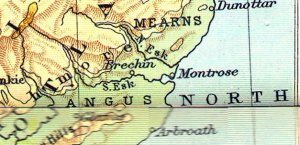 Topographical Map with South Esk and North Esk shown flowing past Montrose into the North Sea, between the Earldom of Angus and the Barony of Mearns (now Kincardineshire) with Brechin, Montrose, Arbroath, Dunottar. The Strrathmore hills run from southwest to northeast parallel to the coast line.
Topographical Map with South Esk and North Esk shown flowing past Montrose into the North Sea, between the Earldom of Angus and the Barony of Mearns (now Kincardineshire) with Brechin, Montrose, Arbroath, Dunottar. The Strrathmore hills run from southwest to northeast parallel to the coast line.
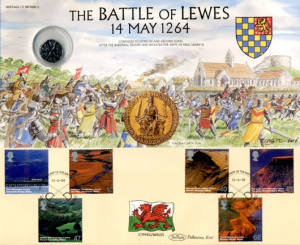 1264 Battle of Lewes in Sussex. Henry III, who was refusing to honor the terms of the Provisions of Oxford, an agreement he had signed with his barons, led by Montfort, in 1258. Henry 3rd was the father of Margaret Queen of Scots who was married to Alexander 3rd King of Scotland.
1264 Battle of Lewes in Sussex. Henry III, who was refusing to honor the terms of the Provisions of Oxford, an agreement he had signed with his barons, led by Montfort, in 1258. Henry 3rd was the father of Margaret Queen of Scots who was married to Alexander 3rd King of Scotland.
www.bfdc.co.uk/2004
Henry III’s and his wife, Eleanor of Provence, daughter, Margaret of England (29 September 1240 – 26 February 1275) was Queen of Scots as the wife of King Alexander III.
1290 Patrick IV, Earl of March, aged 47 at his father’s death, Sir Patrick de Dunbar, Knight, Earl of Dunbar, had livery of his father’s lands on May 14, 1290. It appears that this Earl of Dunbar assumed the additional alternate title Earl of March, as he appeared designated Comes de Marchia at the parliament at Brigham in 1290, for the purpose of betrothing the Princess Margaret to the son of King Edward I of England.
1363 Inchmurdach. Parliament assembled to receive Steward, and Steward’s title to succession was fully recognized and earldom of Carrick, conferred on eldest son, afterwards Robert III. Tytler’s Britannica.
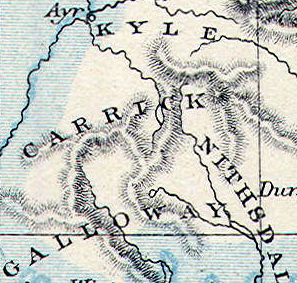 Map of 1285 Scotland showing the Earldom of Carrick between Galloway and Kyle, and Nithsdale to the East. Eventually this becomes Ayrshire.
Map of 1285 Scotland showing the Earldom of Carrick between Galloway and Kyle, and Nithsdale to the East. Eventually this becomes Ayrshire.
1509 Alviano confronted the French at the Battle of Agnadello; outnumbered, he sent requests for reinforcements to his cousin, who replied with orders to break off the battle and continued on his way. Alviano, disregarding the new orders, continued the engagement; his army was eventually surrounded and destroyed. 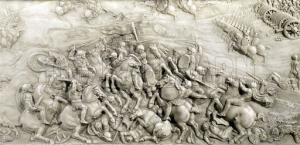 Pitigliano managed to avoid encountering Louis XII of France; but his mercenary troops, hearing of Alviano’s defeat, had deserted in large numbers by the next morning, forcing him to retreat to Treviso with the remnants of the Venetian army.
Pitigliano managed to avoid encountering Louis XII of France; but his mercenary troops, hearing of Alviano’s defeat, had deserted in large numbers by the next morning, forcing him to retreat to Treviso with the remnants of the Venetian army.
www.lookandlearn.com battle art
1534 to 1607 to 1641. Religious persecution laws adopted at various times in these years. The Act of Uniformity, the Test Acts and Penal Laws of England, (with jurisdiction into Ireland, Scotland and British colonies of Africa, India, and Americas), enforced by execution and torture, fine and prison, confiscation and transport to the plantations (American colonies, if ye weren’t already here) were, according to Edmund Burke “a machine of wise and elaborate contrivance, as well fitted for the oppression, impoverishment and degradation of a people, and the debasement in them of human nature itself, as ever proceeded from the perverted ingenuity of man.” Savage, John (1869). Fenian Heroes and Martyrs. Patrick Donahoe. pp. 16. Bans on Catholics, Dissenters from the Established Church, (Nonconformists, Presbyterians, Lutherans, Quakers, Covenanters, Congregationalists, Jews, Anglicans 1650-1661, Baptists, along with slaves, felons, imbeciles. and foreigners) Prohibition on Catholics owning a horse valued at over £5 (in order to keep horses suitable for military activity out of the minority’s hands). Wikipedia. repealed circa 1829.
Bans on Catholics, Dissenters from the Established Church, (Nonconformists, Presbyterians, Lutherans, Quakers, Covenanters, Congregationalists, Jews, Anglicans 1650-1661, Baptists, along with slaves, felons, imbeciles. and foreigners) Prohibition on Catholics owning a horse valued at over £5 (in order to keep horses suitable for military activity out of the minority’s hands). Wikipedia. repealed circa 1829.
1544 As the first major action of the war of the Rough Wooings (a term used 250 years later by Sir Walter Scott), Edinburgh was attacked by an English marine force and burnt. The Salamander and the Scottish-built Unicorn were captured at Leith and used as transport for the return journey of a part of Lord Hertford’s army on 14 May 1544, with ballast of 80,000 Scottish iron cannon-shot. Wikipedia.
 Map with Leith as port for Edinburgh on the Firth of Forth, with battle sites of Preston Pans 1745, two centuries after the Unicorn was taken. Also shown are Dalkeith, Dunfermline, Linlithgow around Edinburgh.
Map with Leith as port for Edinburgh on the Firth of Forth, with battle sites of Preston Pans 1745, two centuries after the Unicorn was taken. Also shown are Dalkeith, Dunfermline, Linlithgow around Edinburgh.
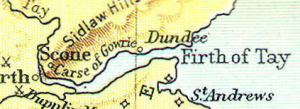 1568 After Battle of Langside (13 May 1568). James Halyburton returns as Provost of Dundee.
1568 After Battle of Langside (13 May 1568). James Halyburton returns as Provost of Dundee.
Dundee on the Firth of Tay, north of St. Andrews, east of Scone, Perth, Carse of Gowrie.
One of 24 Lords of the Congregation. 1551-1565, 1566-1586 James Halyburton (1518 – February 1589), Scottish Protestant reformer, was educated at the University of St Andrews, Fife, where he graduated MA (Master of Arts) in 1538. From 1553 to 1586 he was Provost of St Andrews and a prominent figure in national life. 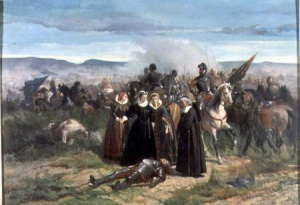 He was chosen as one of the lords of the congregation in 1557, and commanded the contingents sent by Forfar and Fife against Elizabeth I of England in 1559. He took part in the defense of Edinburgh, and in the battles of Langside (1568) and Restalrig (1571). Wikipedia. Painting Mary Stuart at the Battle of Langside.
He was chosen as one of the lords of the congregation in 1557, and commanded the contingents sent by Forfar and Fife against Elizabeth I of England in 1559. He took part in the defense of Edinburgh, and in the battles of Langside (1568) and Restalrig (1571). Wikipedia. Painting Mary Stuart at the Battle of Langside.
Tytler’s History of Scotland from Encyclopaedia Britannica
CHRONOLOGY OF THE PERIOD.
1685, A.D. Sometime in. Edict of Nantes revoked by Louis XIV –Duke of Monmouth beheaded.
- Battle of the Boyne.
- Battle of La Hogue. Battle of Steenkirk.
1697 Peace of Ryswick. –Charles XII. King of Sweden
1701 Dryde
1703 Gibraltar taken by the British.
1704 The Duke of Marlborough defeats the French at Blenheim.
-Peter the Great founds St Petersburgh.
- May 12. Battle of Ramilies.
1708 Battle of Oudenarde.
1709 Battle of Malplaquet.
1713Peace of Utrecht.
1736 Edinburgh execution by hanging of Wilson, smuggler, leads to riots. (TG74-18)
1743 Mutiny of the Black Watch (42nd Regiment as of 1850). The clan Macpherson, in a corps of Highlanders, had been marched to London, preparatory to being sent abroad. Composed of independent companies intended to be confined to the Highlands, the foreign service was an infringement on their compact with government. So they resolved to return to Scotland. After a review on Finchley Common on 14 May 1743, they decamped from the quarters, reached Northampton on their way home, and were discovered and surrendered. 3 were shot, Malcolm and Samuel Macpherson of Druminourd, brother of General Kenneth Macpherson of the East India Company’s service who died in 1815. Anderson v 3/p. 62.
 Macpherson Motto: TOUCH NOT THE CAT BUT A GLOVE.
Badge: white heather, boxwood or red whortleberry. Chief: The Hon. Sir William Macpherson of Cluny-Macpherson, QC. Crest: A cat sejant Proper.
Macpherson Motto: TOUCH NOT THE CAT BUT A GLOVE.
Badge: white heather, boxwood or red whortleberry. Chief: The Hon. Sir William Macpherson of Cluny-Macpherson, QC. Crest: A cat sejant Proper.
1746 May 14. Walked to Coradale in South Uist. Macleod was sent to the mainland to endeavour to get some money for the Prince from Murray of Broughton, who was at Loch Arkaig, with Lochiel and others, and returned unsuccessful after eighteen days’ absence (I. 174, 194,370). H.M. Ship’ ‘Greyhound,’ Baltimore,’ and ‘Terror,’ having repaired damage8, were joined by the Raven’ 8loop on the 4th . H.M. Ships ‘Scarborough,’ and ‘Glasgow,’ and the Sloops Trial ‘ and ‘Happy Janet’ on the 13th , and H.M.S. ‘Furnace’ (Capt. Ferguson) on the 17th.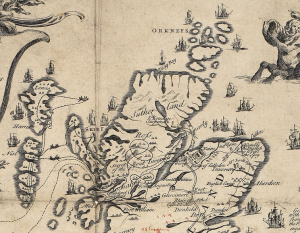 The squadron scoured the coasts (S.M. 239) O’Neil says that Donald MacLeod was sent from Wiskaway, but he himself says (I. 174) he rejoined the Prince at Coradale where he had left him. Publications OF THE SCOTISH HISTORY SOCIETY VOLUME XXIII, Pg 65 (50) April 1897 SUPPLEMENT LYON IN MOURNING PRINCE CHARLES EDWARD STUART ITINERARY AND MAP. Ed.W. B. BLAIKIE, from Narrative of Lord MacLeod, son of the Earl of Cromarty Orkneys
The squadron scoured the coasts (S.M. 239) O’Neil says that Donald MacLeod was sent from Wiskaway, but he himself says (I. 174) he rejoined the Prince at Coradale where he had left him. Publications OF THE SCOTISH HISTORY SOCIETY VOLUME XXIII, Pg 65 (50) April 1897 SUPPLEMENT LYON IN MOURNING PRINCE CHARLES EDWARD STUART ITINERARY AND MAP. Ed.W. B. BLAIKIE, from Narrative of Lord MacLeod, son of the Earl of Cromarty Orkneys
1752 Appin Murder. Fictional David Balfour is the central character of Kidnapped Being Memoirs of the Adventures of David Balfour in the Year 1751: How he was Kidnapped and Cast away; his Sufferings in a Desert Isle; his Journey in the Wild Highlands; his acquaintance with Alan Breck Stewart and other notorious Highland Jacobites; with all that he Suffered at the hands of his Uncle, Ebenezer Balfour of Shaws, falsely so-called: Written by Himself and now set forth by Robert Louis Stevenson.
 1938 theatrical poster Kidnapped. This was based upon the Appin Murder and so many of the other characters, such as Alan Breck Stewart. On 14 May 1752, Colin Roy Campbell of Glenure,
1938 theatrical poster Kidnapped. This was based upon the Appin Murder and so many of the other characters, such as Alan Breck Stewart. On 14 May 1752, Colin Roy Campbell of Glenure,
Campbell Earl of Argyll 1010 2Montgomery2Blair 2Cochrane2Miller 2Simmons2Choate to zoe TOAG
the government-appointed Factor to the forfeited estates of the Stewart Clan in North Argyll, Scotland,  was shot in the back by a marksman in the wood of Lettermore near Ballachulish. Map of 1745 Scotland with Ballachulish in Argyll, with Glen Coe, Dalmally, Loch Linnhe, Rannoch Moor.
was shot in the back by a marksman in the wood of Lettermore near Ballachulish. Map of 1745 Scotland with Ballachulish in Argyll, with Glen Coe, Dalmally, Loch Linnhe, Rannoch Moor.
1754 The Society of St Andrews Golfers is established. The Royal and Ancient Golf Club of St Andrews began on 14 May 1754, when 22 noblemen and gentlemen of Fife presented a Silver Club to be played for annually over the Links of St Andrews. The winner became Captain for the year. The Society of St Andrews Golfers, as the Club was originally known, soon evolved from this competition, meeting regularly to take part in the ‘healthful exercise of golf’, usually followed by a dinner. In 1834, King William IV agreed to become the Patron of the Club and the Society of St Andrews Golfers became The Royal and Ancient Golf Club of St Andrews. The present club house was built by the Union Club, formed in 1835, which formally merged with the Royal and Ancient Club under the Royal and Ancient title in 1877. The Royal and Ancient Golf Club of St Andrews holds a unique position in golf and remains a leading authority in the world game. As the Club celebrated its 250th anniversary in 2004 it devolved responsibility for the administration of the Rules of Golf, the running of The Open Championship and other key events, and the development of the game in existing and emerging golfing nations, to a newly formed group of companies collectively known as ‘The R&A’. As a separate entity the Royal and Ancient Golf Club of St Andrews remains as a private golf club with a world-wide membership of 2,400.’
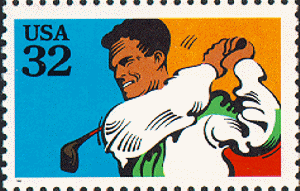 1995 Golf, a game of Scottish origin with records dating back continually to the mid 15th century, 25 million golfers play on nearly 14,000 golf courses in the United States. The United States Golf Association (USGA) was formed in 1894 with the intent to clear up confusion over who should be declared the national amateur golf champion. In 1895, the first U.S. Amateur Championship drew only 32 entries. A day later, the first Open Championship had 11 entrants and a month later, the first Women’s Amateur championship was contested among 13 golfers. Now, the USGA is celebrating 100 years as the rules-making body of golf and the Amateur and Open championships attract 12,000 entries between them.
1995 Golf, a game of Scottish origin with records dating back continually to the mid 15th century, 25 million golfers play on nearly 14,000 golf courses in the United States. The United States Golf Association (USGA) was formed in 1894 with the intent to clear up confusion over who should be declared the national amateur golf champion. In 1895, the first U.S. Amateur Championship drew only 32 entries. A day later, the first Open Championship had 11 entrants and a month later, the first Women’s Amateur championship was contested among 13 golfers. Now, the USGA is celebrating 100 years as the rules-making body of golf and the Amateur and Open championships attract 12,000 entries between them.
1803 William Smith (September 7, 1727 – May 14, 1803)[1][2] was the first provost of the University of Pennsylvania. Smith was born in Aberdeen, Scotland, to Thomas and Elizabeth (Duncan) Smith. He attended the University of Aberdeen and held the degree of Doctor of Divinity from both Aberdeen and Oxford. Bookseller Andrew Millar VI (clans Stewart, Lockhart, Hunter).
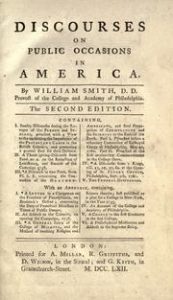 Discourses on public occasions in America, By William Smith D.D. Provost of the College and Academy of Philadelphia. Etc. London Printed for A. Millar, R. Griffiths and D. * in the Strand and G. Keith etc. M.DCC.LXII.
Discourses on public occasions in America, By William Smith D.D. Provost of the College and Academy of Philadelphia. Etc. London Printed for A. Millar, R. Griffiths and D. * in the Strand and G. Keith etc. M.DCC.LXII.
1816 Basil Cochrane (d 14.05.1816, Lt. Colonel) died. Brother to the 9th Earl of Dundonald.
1829 Joseph Smith the Prophet at Harmony, Pennsylvania. (Clan Mack of Inverness, Malcolm King of Scots). Doctrine and Covenants 12. Sometime in May. ‘Therefore, if ye will ask of me ye shall receive; if ye will knock it shall be opened unto you.’
1880 Bertie Charles Forbes born (May 14, 1880 – May 6, 1954) (clan Forbes) was a Scottish financial journalist and author who founded Forbes Magazine. He was born in New Deer, Aberdeenshire, in Scotland. After studying at University of Dundee, in 1897 Forbes worked as a reporter and editorial writer with a local Dundee newspaper until 1901 when he moved to Johannesburg, South Africa, where he founded the Rand Daily Mail. He emigrated to New York City in the United States in 1904.
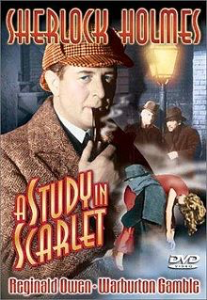 1933 A Study in Scarlet film released. 1887 John Reginald Owen (5 August 1887 – 5 November 1972) died, he was a British character actor and was Sherlock Holmes.
1933 A Study in Scarlet film released. 1887 John Reginald Owen (5 August 1887 – 5 November 1972) died, he was a British character actor and was Sherlock Holmes.
1933 May 14 Poster.
1945 Heber Jeddy Grant (November 22, 1856 – May 14, 1945) was the seventh president of The Church of Jesus Christ of Latter-day Saints. Grant served as church president from November 23, 1918 to his death in 1945, which made him the longest-serving church president during the twentieth century. He was ordained an apostle on October 16, 1882. Grant was born in Salt Lake City, Utah Territory, the son of Rachel Ridgeway (née Ivins) and Jedediah Morgan Grant (February 21, 1816 – December 1, 1856) was a leader and an apostle of The Church of Jesus Christ of Latter-day Saints.
 Grant Crest: A burning hill Proper. Motto: CRAIG ELACHIE.
[from Scottish Gaelic: “The rock of alarm”].
Badge: pine (Scots fir) Chief: James Patrick Trevor Grant of Grant, 6th Baron Strathspey.
Grant Crest: A burning hill Proper. Motto: CRAIG ELACHIE.
[from Scottish Gaelic: “The rock of alarm”].
Badge: pine (Scots fir) Chief: James Patrick Trevor Grant of Grant, 6th Baron Strathspey. 
Heber J. Gant’s signature.
1974 Skylab Issue of 1974 ~ space stamp.
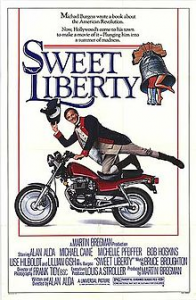 1986 Sweet Liberty (1986) released.
1986 Sweet Liberty (1986) released.
Theatrical release poster. College history professor Michael Burgess is about to have his fact-based historical novel about Battle of Cowpens turned into a Hollywood motion picture being filmed in the North Carolina town where he lives. While both stars argue for more screen time, Michael must also deal with his ancient mother Cecelia and his girlfriend Gretchen. The locals cause explosions during a horribly inaccurate recreation of the Battle of Cowpens.
Back story. The 1781 Battle of Cowpens was attended by Colonel Andrew Pickens of the South Carolina militia (wife clan Calhoun), and Lieutenant Colonel Banastre Tarleton of the British dragoons.
2014 Utah is ranked 2nd highest (4.6% of the state population) among the 50 United States with the top percentages of Scottish residents (Wikipedia 26 March 2017 https://en.wikipedia.org/wiki/Scottish_Americans#Scottish_Americans_by_state ). How are the Scots in Utah doing? Brigham Young University, based in Provo, Utah, was ranked the most sober school for the 17th year in a row by the Princeton Review. 2014 http://www.huffingtonpost.com/2014/08/04/brigham-young-sober-school_n_5648703.html
Disclaimer: The author of each article published on this web site owns his or her own words. The opinions, beliefs and viewpoints expressed by the various authors and forum participants on this site do not necessarily reflect the opinions, beliefs and viewpoints of Utah Standard News or official policies of the USN and may actually reflect positions that USN actively opposes. John Choate © No claim in public domain or fair use.
Utah Standard News depends on the support of readers like you.
Good Journalism requires time, expertise, passion and money. We know you appreciate the coverage here. Please help us to continue as an alternative news website by becoming a subscriber or making a donation. To learn more about our subscription options or make a donation, click here.
To Advertise on UtahStandardNews.com, please contact us at: ed@utahstandardnews.com.


Comments - No Responses to “May 14th Scots book of days”
Sure is empty down here...